 W
WAlexandra Fountain in the Australian city of Bendigo, Victoria, is regarded as one of the city's most prominent landmarks and monuments.
 W
WAllegory of the Planets and Continents is a 1752 painting by Italian artist Giovanni Battista Tiepolo. Done in oil on canvas, the allegorical work uses human figures to represent members of the Greco-Roman pantheon, the planets, and four continents. The painting is an elaborate oil sketch made by Tiepolo in preparation for rendering a similar, larger version of his scene.
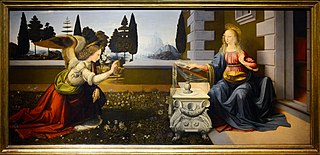 W
WThe Annunciation is a painting widely attributed to the Italian Renaissance artist Leonardo da Vinci, dated to c. 1472–1476. Leonardo's earliest extant major work, it was completed in Florence while he was an apprentice in the studio of Andrea del Verrocchio. The painting was made oil and tempera on a large poplar panel and depicts the Annunciation, a popular biblical subject in 15th-century Florence. Since 1867 it has been housed in the Uffizi in Florence, the city were it was created. Though the work has been criticized for inaccuracies in its composition, it is among the best known portrayals of the Annunciation in Christian art.
 W
WThe Atlas Fountain stands in the grounds of Castle Howard, North Yorkshire, England. It has been designated a Grade I listed building and is now recorded in the National Heritage List for England, maintained by Historic England.
 W
WThe Bartholdi Fountain is a monumental public fountain, designed by Frédéric Auguste Bartholdi, who later created the Statue of Liberty. The fountain was originally made for the 1876 Centennial Exposition in Philadelphia, Pennsylvania, and is now located at the corner of Independence Avenue and First Street, SW, in the United States Botanic Garden, on the grounds of the United States Capitol, in Washington D.C..
 W
WThe Birth of Venus is one of the most famous paintings by 19th-century painter William-Adolphe Bouguereau. It depicts not the actual birth of Venus from the sea, but her transportation in a shell as a fully mature woman from the sea to Paphos in Cyprus. She is considered the epitome of the Classical Greek and Roman ideal of the female form and beauty, on par with Venus de Milo.
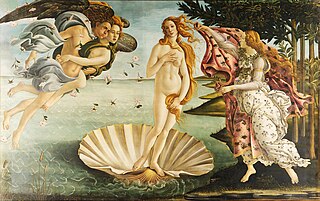 W
WThe Birth of Venus is a painting by the Italian artist Sandro Botticelli, probably executed in the mid 1480s. It depicts the goddess Venus arriving at the shore after her birth, when she had emerged from the sea fully-grown. The painting is in the Uffizi Gallery in Florence, Italy.
 W
WThe Cijin Shell Museum is a museum in Cijin District, Kaohsiung, Taiwan.
 W
WThe Court of Neptune Fountain is a group of bronze sculptures made by Roland Hinton Perry in 1897–98. Jerome Connor may have assisted in their manufacture.
 W
WDrunken Silenus is a painting by Jusepe de Ribera, produced in 1626 in Naples and now in the Museo di Capodimonte in Naples.
 W
WThe Dupont Circle Fountain, formally known as the Rear Admiral Samuel Francis Dupont Memorial Fountain, is a fountain located in the center of Dupont Circle in Washington, D.C. It honors Rear Admiral Samuel Francis Du Pont, a prominent American naval officer and member of the Du Pont family. The fountain replaced a statue of Du Pont that was installed in 1884. Designed by Henry Bacon and sculpted by Daniel Chester French, the fountain was dedicated in 1921. Prominent guests at the dedication ceremony included First Lady Florence Harding, Secretary of War John W. Weeks and Secretary of the Navy Edwin Denby.
 W
WThe Fontaine de l'Observatoire is a monumental fountain located in the Jardin Marco Polo, south of the Jardin du Luxembourg in the 6th arrondissement of Paris, with sculpture by Jean-Baptiste Carpeaux. It was dedicated in 1874. It is also known as the Fontaine des Quatre-Parties-du-Monde, for the four parts of the world embodied by its female figures, or simply the Fontaine Carpeaux.
 W
WThe Fontaine des Innocents is a monumental public fountain located on the place Joachim-du-Bellay in the Les Halles district in the 1st arrondissement of Paris, France. Originally called the Fountain of the Nymphs, it was constructed between 1547 and 1550 by architect Pierre Lescot and sculptor Jean Goujon in the new style of the French Renaissance. It is the oldest monumental fountain in Paris.
 W
WThe two fontane dei mostri marini are located in the Santissima Annunziata plaza in Florence.
 W
WFontana del Moro is a fountain located at the southern end of the Piazza Navona in Rome, Italy. It represents a Moor, or African, standing in a conch shell, wrestling with a dolphin, surrounded by four Tritons. It is placed in a basin of rose-colored marble.
 W
WFontana del Tritone is a seventeenth-century fountain in Rome, by the Baroque sculptor Gian Lorenzo Bernini. Commissioned by his patron, Pope Urban VIII, the fountain is located in the Piazza Barberini, near the entrance to the Palazzo Barberini that Bernini helped to design and construct for the Barberini, Urban's family. This fountain should be distinguished from the nearby Fontana dei Tritoni by Carlo Francesco Bizzaccheri in Piazza Bocca della Verità which features two Tritons.
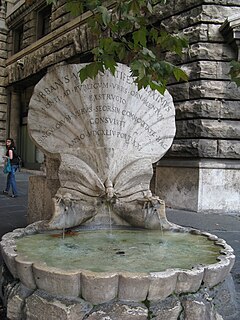 W
WFontana delle Api is a fountain located in the Piazza Barberini in Rome where the Via Veneto enters the piazza. It was sculpted by Gian Lorenzo Bernini and completed in April 1644.
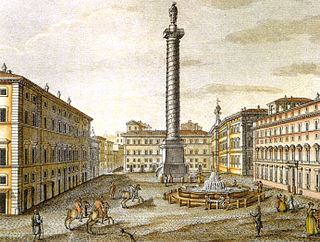 W
WThe fountain in the Piazza Colonna is a fountain in Rome, Italy, designed by the architect Giacomo Della Porta and constructed by the Fiesole sculptor Rocco Rossi between 1575 and 1577.
 W
WThe Fountain in Piazza Santa Maria in Trastevere is a fountain located in the square in front of the church of Santa Maria in Trastevere, Rome, Italy. It is believed to be the oldest fountain in Rome, dating back, according to some sources, to the 8th century. The present fountain is the work of Donato Bramante, with later additions by Gian Lorenzo Bernini and Carlo Fontana.
 W
WThe Fountain of the Tritons is a fountain in Rome (Italy), Piazza Bocca della Verità, in front of the basilica of Santa Maria in Cosmedin. This fountain should be distinguished from the similarly named nearby Triton Fountain by Gian Lorenzo Bernini, in the Piazza Barberini, with only a single Triton.
 W
WThe Triumph of Galatea is a fresco completed around 1512 by the Italian painter Raphael for the Villa Farnesina in Rome.
 W
WThe Garden of Earthly Delights is the modern title given to a triptych oil painting on oak panel painted by the Early Netherlandish master Hieronymus Bosch, between 1490 and 1510, when Bosch was between 40 and 60 years old. It has been housed in the Museo del Prado in Madrid, Spain since 1939.
 W
WHercules's Dog Discovers Purple Dye or The Discovery of Purple by Hercules's Dog is an oil painting by Flemish artist Peter Paul Rubens painted circa 1636, towards the end of his career. It depicts the mythical discovery of Tyrian purple by Hercules and his dog, and was one of dozens of oil on panel sketches made by Rubens for the decoration of the Torre de la Parada in Spain. A completed painting based on Rubens's sketch was made by Theodoor van Thulden in 1636-8, and is now held by the Prado Museum.
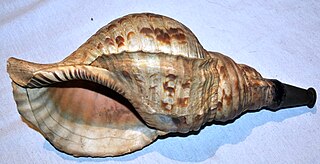 W
WHoragai are large conch shells, usually from Charonia tritonis, that have been used as trumpets in Japan for many centuries. The instrument, which has served a number of purposes throughout Japanese history, has been given a number of Japanese names depending on its function. Special schools still teach students to play the traditional music associated with the conch.
 W
WLong-nosed god maskettes are artifacts made from bone, copper and marine shells associated with the Mississippian culture and found in archaeological sites in the American Midwest and Southeast. They are small shield-shaped faces with squared-off foreheads, circular eyes, and large noses of various lengths. They are often shown on Southeastern Ceremonial Complex representations of falcon impersonators as ear ornaments. Long and short nosed versions of the masks have been found in ten different states, with the majority found at sites in Illinois. Many archaeologists now associate them with the Ho-Chunk (Winnebago) stories of the mythological being Red Horn.
 W
WThe Madonna of Port Lligat is a pair of paintings by Salvador Dalí. The first was created in 1949, measuring 49 x 37.5 centimetres (19.3 x 14.8 in), and is housed in the Haggerty Museum of Art at Marquette University in Milwaukee, Wisconsin, USA. Dalí presented it to Pope Pius XII in an audience for approval, which was granted. Dalí created a second painting in 1950 with the same title and same themes, with various poses and details changed, measuring 275.3 x 209.8 centimetres (108.4 x 82.6 in). The 1950 Madonna is exhibited at the Fukuoka Art Museum in Japan.
 W
WNeptune, Neptune Calming the Waves or Irritated Neptune is a 1767 marble sculpture of Neptune by the French artist Augustin Pajou, now in the Museum of Fine Arts of Lyon. He produced a terracotta modello for the work.
 W
WNeptune and Triton is an early sculpture by the Italian artist Gian Lorenzo Bernini. It is housed in the Victoria and Albert Museum of London and was executed c. 1622–1623. Carved from marble, it stands 182.2 cm (71.7 in) in height.
 W
WA Once and Future Shoreline is a permanent public artwork that graphically marks the edge of Boston Harbor, circa 1630, into the granite paving blocks of the plaza on the West side of the historic Faneuil Hall building. The 850-foot-long artwork depicts the location of a pre-colonial shoreline by graphically etching silhouettes of materials that are found typically along the high tide line. The artwork offers a way to engage the imagination in an exploration of the changes to this now urban site from a salty tidal marsh, to an active pedestrian plaza.
 W
WThe Oyster Eater or Girl Offering Oysters, is a c.1658-1660 small oil on panel painting by Jan Steen. Since 1936, it has been in the collection of the Mauritshuis in the Hague. This is a genre painting that demonstrates Steen's more intricate style and use of domestic settings. It also shows Steen's use of symbolism with oysters to create a theme of earthly lust.
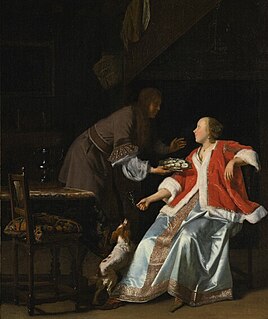 W
WThe Oyster Meal is an oil on canvas genre painting by the Dutch Golden Age artist Jacob Ochtervelt, dated to around 1664–65. It depicts a man offering a plate of oysters to a woman he is trying to seduce.
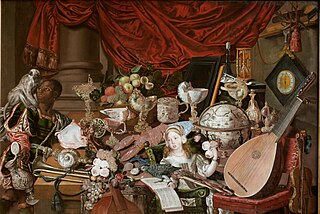 W
WThe Paston Treasure is a historically rare record of a cabinet of treasures in British collecting. Commissioned by either Sir Robert Paston or his father Sir William Paston in the early 1670s, the oil painting depicts a small fraction of the Paston family's collected treasures. It was executed by an unknown Dutch artist who resided at the Paston family residence at Oxnead Hall near Aylsham in Norfolk for approximately 3 months, in order to complete the commission.
 W
WThe Peace Monument, also known as the Naval Monument or Civil War Sailors Monument, stands on the grounds of the United States Capitol in Peace Circle at First Street, N.W., and Pennsylvania Avenue, Washington, D.C. The 44 foot high white marble memorial was erected from 1877 to 1878 in commemoration of the naval deaths at sea during the American Civil War. Today it stands as part of a three-part sculptural group including the James A. Garfield Monument and the Ulysses S. Grant Memorial.
 W
WRaden (螺鈿) is a Japanese term for one of the decorative techniques used in traditional crafts such as Japanese lacquerware and woodwork. It refers to a method of inserting a board-like material, which is a cut out part of the mother of pearl inside the shell, into the carved surface of lacquer or wood, or a craft made by using this method. The kanji for ra (螺) means shell and den (鈿) means inlaid. "Raden" is a term used only for the technique or work of inlaying thin layers of pearl shells. In Japan, the technique to inlay ivory or metal is simply called "象嵌, zougan or zōgan" which means inlay.
 W
WA sailor's valentine is a form of shellcraft, a type of mostly antique souvenir, or sentimental gift made using large numbers of small seashells. These were originally made between 1830 and 1890, and they were designed to be brought home from a sailor's voyage at sea and given to the sailor's loved one or loved ones. Sailor valentines are typically octagonal, glass fronted, hinged wooden boxes ranging from 8 to 20 inches in width, displaying intricate symmetrical designs composed entirely of small sea shells of various colors glued onto a backing. Patterns often feature a centerpiece such as a compass rose or a heart design, hence the name, and in some cases the small shells are used to spell out a motto or sentimental message.
 W
WShell gorgets are a Native American art form of polished, carved shell pendants worn around the neck. The gorgets are frequently engraved, and are sometimes highlighted with pigments, or fenestrated.
 W
WShell jewelry is jewelry that is primarily made from seashells, the shells of marine mollusks. Shell jewelry is a type of shellcraft. One very common form of shell jewelry is necklaces that are composed of large numbers of beads, where each individual bead is the whole shell of a small sea snail. Numerous other varieties of shell jewelry are made, including bracelets and earrings.
 W
WA statue of military historian Samuel Eliot Morison by Penelope Jencks is installed along Boston's Commonwealth Avenue Mall, in the U.S. state of Massachusetts.
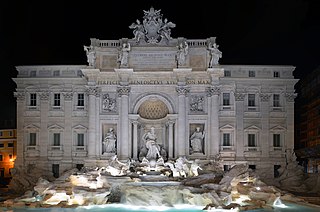 W
WThe Trevi Fountain is a fountain in the Trevi district in Rome, Italy, designed by Italian architect Nicola Salvi and completed by Giuseppe Pannini and several others. Standing 26.3 metres (86 ft) high and 49.15 metres (161.3 ft) wide, it is the largest Baroque fountain in the city and one of the most famous fountains in the world.
 W
WThe USS Maine National Monument is an outdoor monument located at the Merchants' Gate entrance to Central Park, at Columbus Circle, in Manhattan, New York City. It was cast on September 1, 1912 and dedicated on May 30, 1913 to the men killed aboard USS Maine (ACR-1) when the ship exploded in Havana harbor.
 W
WVenus Anadyomene, is a c. 1520 oil painting by Titian, depicting Venus rising from the sea and wringing her hair, after her birth fully-grown. Venus, said to have been born from a shell, is identified by the shell at bottom left. It is smaller than usual in the birth of Venus scenes, such as Botticelli's, and is just intended to identify the subject rather than be a boat-like vessel for Venus, as in Sandro Botticelli's The Birth of Venus and other depictions.
 W
WVenus and Cupid is a painting by Lorenzo Lotto in the collection of the Metropolitan Museum of Art. It probably dates to c. 1530, but has been dated from the mid 1520s as late as the 1540s.
 W
WWhat the Water Gave Me is an oil painting by Frida Kahlo that was completed in 1938. It is sometimes referred to as What I Saw in the Water.